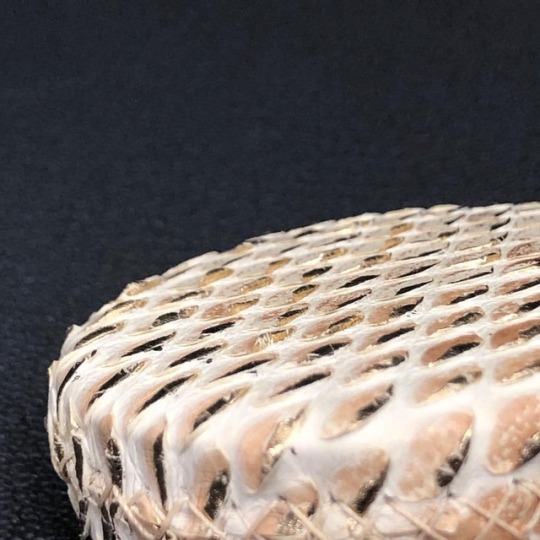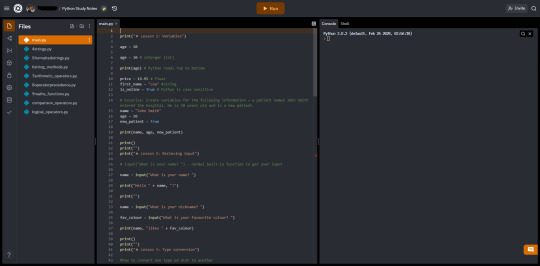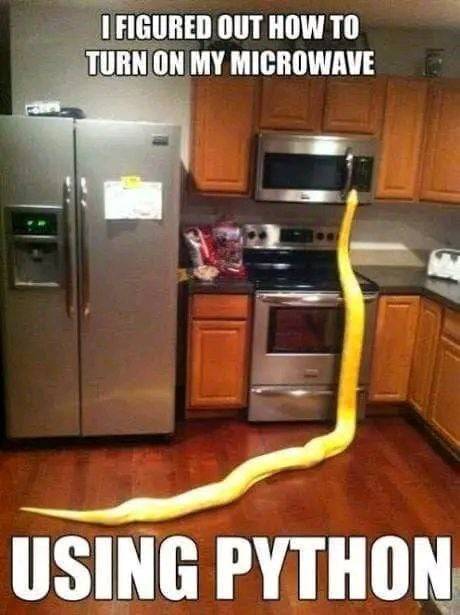#realpython
Explore tagged Tumblr posts
Photo

Real python leather measuringtape by x-stitch 줄자에 리얼파이톤 가죽커버링 #crossstitch #measuringtape #miroarte #leather #leathergoods #leatherwork #leathercraft #leatherbag #leatherworks #handmade #handsewn #handstitch #ordermade #bespoke #custommade #design #daily #pueblo #realpython #pythonleather #zoom #가죽공방 #주문제작 #미로아르테 #가죽가방 #수제가방 #수제공방 #핸드메이드 #줄자 #가죽줄자 #파이톤 #리얼뱀피(미로아르테에서) https://www.instagram.com/p/BuGfdx0FocK/?utm_source=ig_tumblr_share&igshid=1um7yqii7hf2m
#crossstitch#measuringtape#miroarte#leather#leathergoods#leatherwork#leathercraft#leatherbag#leatherworks#handmade#handsewn#handstitch#ordermade#bespoke#custommade#design#daily#pueblo#realpython#pythonleather#zoom#가죽공방#주문제작#미로아르테#가죽가방#���제가방#수제공방#핸드메이드#줄자#가죽줄자
1 note
·
View note
Text
Learning Python: Week 1

Happy New Year! Frohes Neues Jahr! The New Year is here and a lot of people want to learn coding as one of their New Years' Resolution, so I am here to give my very own Python self-taught curriculum (which I made a couple of months ago) but thought it would be helpful even now! Anyways, let me help you with your very first week learning Python!
What is the Python Self-Curriculum? ♥

It is this! I made it whilst I was (and still am) learning Python a couple months ago. This is a weekly checklist of what you need to learn initially with Python - thus this is not all you need to learn with Python but basically a foundational start! You can even use the curriculum just as a pointer of making sure you're covering the right topics whilst learning so you're not just aimlessly going through tutorial after tutorial and not learning anything for real! Anyways here is the link! :
Python Self-Curriculum ♥
Week 1: Intro to Python - checklist ♥
☐ First Python Program
☐ Python Identifiers, Keywords, and Indentation
☐ Comments and document interlude in Python
☐ Command-line arguments
☐ Getting User Input
☐ Python Data Types
☐ What are variables?
☐ Python Core objects and Functions
☐ Python Number and Maths
"Wait! Hold on! How do I ACTUALLY start??!!" ♥
Okay, okay! I gave you a list but if you're a complete beginner to coding you'll have no idea how to actually start - oops. So, here are a few pointers! :
♥ You need a place to ACTUALLY code:
Online : OnlineIDE or Replit
Install to your computer : PyCharm (highly recommended!!) - I do recommend watching this youtube tutorial on how to install if you are stuck!
♥ Websites to help throughout your first week!
Programiz - Python
RealPython
LearnPython
♥ Videos to help throughout your first week!
The YouTube playlist I made!
♥ Books to help throughout your journey of learning Python!
[John Paul Mueller] Beginning Programming with Python for Dummies
[Zed A. Shaw] Learn Python 3 the Hard Way A Very Simple Introduction to the Terrifyingly Beautiful World of Computers and Code
[Al Sweigart] Automate the boring stuff with Python
(If you don't want to pay for them, visit this website - but shhh I didn't tell you~)
How I keep notes ♥
I use paper notes, a Replit online, and on OneNote from Mircosoft


That's all but... ♥
♥ Remember to keep yourself motivated! Coding is bloody hard (coming from a non-mathsy person!), I'm not going to sugar coat it, it's hard.
♥ I'm not saying studying 8 hours per day, even 1-hour studying is better than none at all!
♥ More hands-on coding than just reading the material! You don't read to learn a bike, you get on and ride!
♥ Failing is way okay with coding - just know where you went wrong and plow ahead!
♥ Google, google, google - whenever you're stuck, just google it! Someone made the same mistake and was stuck just like you!
♥ Record your progress! Look at me, making a whole Tumblr blog just about me coding! You can make an Instagram, Twitter, GitHub (highly recommended), Facebook account to track your very first code to then compare it to when you're all amazing at programming!
I too will be posting my progress throughout this week to prove it is possible to learn! And eventually, you'll be making cool-ass programs! Remember:
"Slow and steady wins the race.”
— Aesop
#learn pyt#coding#programming#software developer#projetcs#100 days of code#python programming#how to learn python#Coding#Programming#Computer Science#backend#python#study plan#sharing is caring
43 notes
·
View notes
Photo

RT @realpython: 🐍📰 Python Development in Visual Studio Code https://t.co/lS9j4al786
2 notes
·
View notes
Photo

Just letting Python community know that I have begun programming PI - “Pee I” - 3.14… and note my_new_car is Lamborghini Sian FKP 37 😎 @realpython @python.hub @realpython @pythonfoundation @python3learning #hgohd #harjgtheonedba #harjgtheone #hwoworld @phys.org1 @lamborghini @vw @BBCWorld @cp24breakingnews @nypost @nyse @cia @rcmpgrcpolice (at Toronto, Ontario)
https://www.instagram.com/p/CN0RV9-jCgJ/?igshid=1dmq019lj3cgk
0 notes
Link
🐍 Continuous Integration With Python 📺(Video) https://t.co/0wby6EfAEm
— Real Python (@realpython) November 5, 2019
via: https://ift.tt/1GAs5mb
0 notes
Text
ToddRBirchard
PyBoy: Game Boy Emulator Written in Python #python https://t.co/s53ZclLjP5
— Real Python (@realpython) April 24, 2020
http://twitter.com/ToddRBirchard/status/1253519769430568960
0 notes
Text
How do I start learning Python for beginners?
Python training has become one of the most widely used programming languages in the world due to its simplicity, readability, and versatility. Whether you're a student, a professional looking to change careers, or simply someone curious about programming, Python is an excellent language to start with. But how do you get started? This detailed guide will walk you through everything you need to know to begin your journey with Python—from understanding the basics to building your first projects.
Why Choose Python as Your First Programming Language?
Before diving into the steps to learn Python, it’s important to understand why Python is often recommended for beginners:
1. Easy-to-Read Syntax
Python code reads like English, which makes it easier for beginners to understand what’s happening in their programs.
2. Versatile Applications
You can use Python for a wide range of applications including web development, data analysis, machine learning, artificial intelligence, automation, game development, and more.
3. Strong Community and Resources
With a huge global community and abundant learning resources, Python is well-supported. You’ll find tons of free tutorials, videos, books, and forums.
Step-by-Step Guide to Learning Python for Beginners
Let’s now explore how to learn Python in a structured, beginner-friendly way.
Step 1: Understand What Python Is and What It Can Do
Start by getting an overview of Python—what it is, how it works, and where it is used. Some key points to understand:
Python is an interpreted, high-level programming language.
It supports multiple programming paradigms including procedural, object-oriented, and functional programming.
It is used by companies like Google, NASA, Netflix, Instagram, and more.
You can explore beginner-friendly blogs, videos, and articles to get a clear picture.
Step 2: Set Up Your Environment
To begin writing Python code, you need to set up Python on your computer.
a. Install Python
Go to the
Download the latest version of Python (Python 3.x).
During installation, make sure to check the box that says “Add Python to PATH”.
Once installed, you can open your command prompt (Windows) or terminal (Mac/Linux) and type python to check if it’s working.
b. Choose an IDE or Code Editor
An Integrated Development Environment (IDE) is where you’ll write and run your Python code. Some beginner-friendly options include:
IDLE: Comes with Python.
Thonny: Specifically designed for beginners.
VS Code: Popular, lightweight, and extensible.
PyCharm: Powerful professional-grade IDE.
Step 3: Learn the Basics of Python
Begin by learning Python's foundational concepts. Focus on understanding and writing basic code before moving to advanced topics.
Core Concepts to Learn:
Variables and Data Types pythonCopyEditname = "Alice" age = 25 is_student = True
Arithmetic and Logical Operations
Control Flow (if/else statements) pythonCopyEditif age > 18: print("Adult") else: print("Minor")
Loops (for and while) pythonCopyEditfor i in range(5): print(i)
Functions pythonCopyEditdef greet(name): return "Hello " + name
Lists, Tuples, Dictionaries
String Manipulation
Recommended Resources:
W3Schools Python
RealPython
YouTube Channels like Corey Schafer, Programming with Mosh, and Tech With Tim
Step 4: Practice Writing Code Daily
Programming is a skill that improves with practice. Start solving simple problems every day.
What You Can Practice:
Write a program that prints your name.
Create a simple calculator.
Write a number guessing game.
Automate a repetitive task on your computer.
Use platforms like:
HackerRank
LeetCode
Codewars
Step 5: Work on Small Projects
Projects help reinforce what you've learned and give you practical experience. Some ideas for beginners:
To-Do List Application
Simple Quiz Game
BMI Calculator
Currency Converter
Password Generator
When working on projects, don’t be afraid to make mistakes. Debugging and problem-solving are essential parts of learning to code.
Step 6: Understand Object-Oriented Programming (OOP)
Once you're comfortable with basics, dive into OOP. Python is an object-oriented language, and understanding these concepts will help you write cleaner, more organized code.
Key Concepts:
Classes and Objects
Inheritance
Encapsulation
Polymorphism
pythonCopy
Edit
class Dog: def __init__(self, name): self.name = name def bark(self): print(self.name + " says woof!") my_dog = Dog("Buddy") my_dog.bark()
Step 7: Learn Python Libraries and Frameworks
Python's real power lies in its ecosystem of libraries and frameworks. Depending on your area of interest, explore the following:
For Data Science and Machine Learning:
NumPy
Pandas
Matplotlib
Seaborn
Scikit-learn
For Web Development:
Flask
Django
For Automation:
Selenium
PyAutoGUI
Requests
BeautifulSoup
Install libraries using pip:
bashCopy
Edit
pip install pandas
Step 8: Join the Python Community
Learning is more effective when you're part of a community. You can ask questions, get feedback, and stay motivated.
Popular Communities:
Stack Overflow
Reddit r/learnpython
Python Discord Servers
GitHub
Participating in open-source projects or contributing to beginner-friendly repos is a great way to learn and showcase your skills.
Step 9: Build a Portfolio
As you gain confidence, start working on larger projects and build a portfolio. A portfolio helps demonstrate your skills to potential employers or clients.
Tips for Your Portfolio:
Host your code on GitHub.
Include documentation and clear readme files.
Add links to live demos (if applicable).
Highlight your thought process and problem-solving approach.
Step 10: Take Online Courses or Enroll in a Bootcamp
While self-learning is great, enrolling in a structured course can speed up your progress.
Recommended Platforms:
Coursera – Python for Everybody (University of Michigan)
edX
Udemy
freeCodeCamp
Common Mistakes to Avoid
Trying to learn everything at once: Stick to one topic until you understand it well.
Skipping the basics: Make sure your foundation is solid before moving on.
Not practicing: Coding is a hands-on skill; practice is non-negotiable.
Comparing yourself to others: Everyone learns at a different pace. Focus on your own journey.
Final Thoughts
Starting with Python can seem overwhelming at first, but with the right approach, it can be one of the most rewarding experiences. Begin by understanding the basics, setting up your environment, and practicing regularly. As you progress, start building projects and exploring specialized libraries or frameworks that align with your interests.
Remember, the key to learning Python—or any programming language—is consistency. Even spending 30–60 minutes a day writing code can make a huge difference over time. Be patient with yourself, keep coding, and most importantly—enjoy the journey.
0 notes
Text
A tweet
Raise Better Exceptions in Python #python https://t.co/lMyxRqm93t
— Real Python (@realpython) November 28, 2019
0 notes
Text
RT @realpython: 🤖 ⌨ https://t.co/MUquJg59rG
🤖 ⌨ pic.twitter.com/MUquJg59rG
— Real Python (@realpython) April 4, 2019
from Twitter https://twitter.com/sinsonido April 04, 2019 at 02:01PM via IFTTT
0 notes
Photo

Building and Documenting Python REST APIs With Flask and Connexion – Part 2 via @realpython https://t.co/f7lLBTtwOQ #python #api https://t.co/xXNmRcSON2 (via Twitter http://twitter.com/PythonWeekly/status/1050008098646224896) #Python
0 notes
Link
RT @ThePSF: Want to contribute? To report a bug in the Python core, use the @ThePSF Python Bug Tracker: https://t.co/HfPVQmXSgw via @realpython
0 notes
Link
🐍📺 Continuous Integration With Python — https://t.co/0wby6EfAEm pic.twitter.com/7ubMhJN4Qq
— Real Python (@realpython) September 25, 2019
via: https://ift.tt/1GAs5mb
0 notes
Text
Liked a Tweet
PyBoy: Game Boy Emulator Written in Python #python https://t.co/s53ZclLjP5
— Real Python (@realpython) April 24, 2020
from http://twitter.com/realpython
0 notes
Text
#Python Flask: Pt 2/8 @RealPython #Angularjs adding PostgreSQL/SQL-Alchemy #100DaysOfCode… https://t.co/0I1EW7POdB #blog
— JavaScript Facts (@mentallion) October 10, 2017
0 notes
